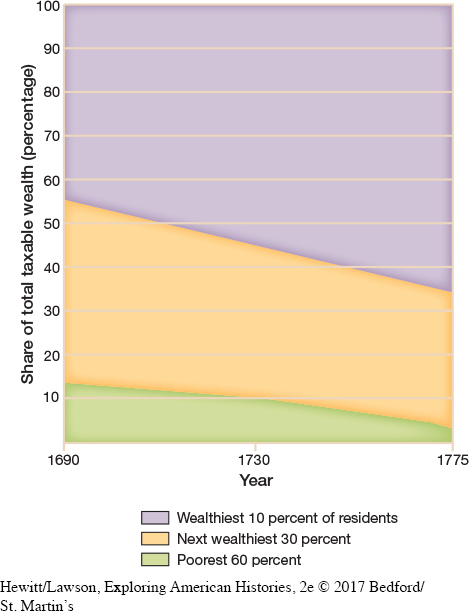Population Growth and Economic Competition
After 1700, the population grew rapidly across the colonies. In 1700 about 250,000 people lived in England’s North American colonies. By 1725 that number had doubled, and fifty years later it had reached 2.5 million. Much of the increase was due to natural reproduction, but in addition nearly 250,000 immigrants and Africans arrived in the colonies between 1700 and 1750.
Because more women and children arrived than in earlier decades, higher birthrates and a more youthful population resulted. At the same time, most North American colonists enjoyed a better diet than their counterparts in Europe and had access to more abundant natural resources. Thus colonists in the eighteenth century began living longer, with more adults surviving to watch their children and grandchildren grow up.
However, as the population soared, the chance for individuals to obtain land or start a business of their own diminished. Those who had established businesses early generally expanded to meet new needs, making it more difficult for others to compete. Those bent on making their living from the land often found the soil exhausted in long-settled regions. On the frontier, settlers might have to carve out farms amid forests, swamps, or areas already claimed by Indian, French, or Spanish residents. While owning land did not automatically lead to prosperity, those who were landless had to find work as tenant farmers, laborers, or in other unskilled occupations. In the South Carolina backcountry, a visitor in the mid-eighteenth century noted that many residents “have nought but a Gourd to drink out of, nor a Plate, Knive or Spoon, a Glass, Cup, or anything.”

In prosperous parts of the Middle Atlantic colonies like Pennsylvania, many landless laborers abandoned rural life and searched for urban opportunities. They moved to Philadelphia or other towns and cities in the region, seeking jobs as dockworkers, street vendors, or servants, or as apprentices in one of the skilled trades. But newcomers found the job market flooded and the chances for advancement growing slim (Figure 4.1).
In the South, too, divisions between rich and poor became more pronounced in the early decades of the eighteenth century. Tobacco was the most valuable product in the Chesapeake, and the largest tobacco planters lived in relative luxury. They developed mercantile contacts in seaport cities on the Atlantic coast and in the Caribbean and imported luxury goods from Europe. They also began training some of their slaves as domestic workers to relieve wives and daughters of the strain of household labor.
Small farmers could also purchase and maintain a farm based on the profits from tobacco. In 1750 two-thirds of white families farmed their own land in Virginia, a larger percentage than in northern colonies. An even higher percentage did so in the Carolinas. Yet small farmers became increasingly dependent on large landowners, who controlled markets, political authority, and the courts. Many artisans, too, depended on wealthy planters for their livelihood, either working for them directly or for the shipping companies and merchants that relied on plantation orders. And the growing number of tenant farmers relied completely on large landowners for their sustenance.
Some southerners fared far worse. One-fifth of all white southerners owned little more than the clothes on their backs in the mid-eighteenth century. At the same time, free blacks in the South found their opportunities for landownership and economic independence increasingly curtailed, while enslaved blacks had little hope of gaining their freedom and held no property of their own.
Exploring American HistoriesPrinted Page 117
Exploring American Histories Value EditionPrinted Page 89
Chapter Timeline